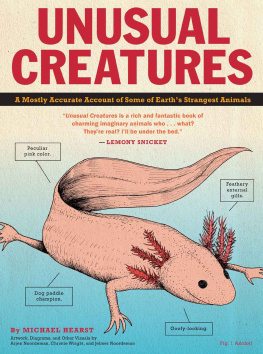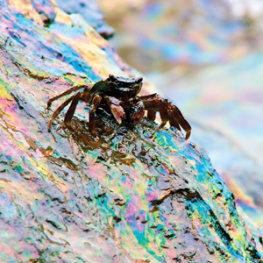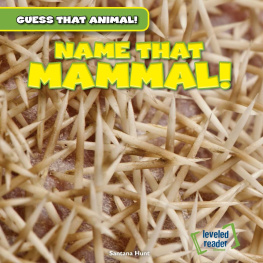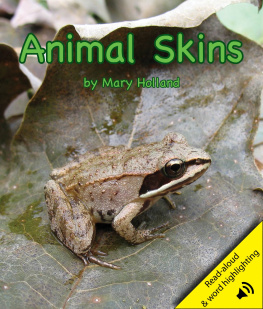Who loves strange animals? Chances are you do if you bought this book. (Then again, perhaps your uncle gave it to you.) Whatever the case may be my name is Michael Hearst, and Id like to share with you some of my favorite unusual creatures. You ask, Whats an unusual creature? Well, heres my definition
un-u-su-al crea-ture (n-y-zh-wl kr-chr) noun. An animal that looks, sounds, smells, or acts in a way that makes you stop and say, Whoa, dude! Whats up with that?
Truth be told, I love all animals. (If I had my way, I would have a pet giraffe that lived in my backyard; I would name it Ruth, and I would feed it acacia leaves from my second-floor bedroom window.) However, for these pages, we will focus on some of the lesser-known animals to roam the earth. I hope you have as much fun reading and looking through this book as I had putting it together. And I really hope at least a few of these unusual creatures make you stop and say, Whoa, dude! Whats up with that?
Michael Hearst

Michael Hearst with one of his unusual creature instruments, the claviola.
IF YOU HAPPEN TO BE A BIOLOGIST (WHICH IS A SCIENTIST WHO STUDIES ANIMALS AND PLANTS AND THEIR RELATIONSHIP TO EVERYTHING AROUND THEM), YOU WILL WANT TO BREAK DOWN THE CLASSIFICATION OF EACH ANIMAL INTO THE FOLLOWING:

You can memorize this list by taking the first letter of each category and placing it in the following mnemonic:
K ids P lace C andles
O n F oot G ravy S ausage.
TO FURTHER UNDERSTAND HOW THIS LIST WORKS, LETS LOOK AT THE DOMESTIC DOG AS AN EXAMPLE.
KINGDOM: Animalia, An animal (i.e., not a plant).
PHYLUM: Chordata, A vertebrate.
CLASS: Mammalia, A mammal, which means it is air-breathing, has hair, and has three middle-ear bones.
ORDER: Carnivora, A carnivoreit eats meat!
FAMILY: Canidae, A wolf- or fox-like animal.
GENUS: Canis, It is in the genus that houses coyotes, jackals, and wolves, among others.
SPECIES: Canis lupus, The wolf species.
SUBSPECIES: Canis lupus familiaris, And finally, here is the exact Latin term for the common domestic dog, descended from the wolf.
(YES, THERE CAN BE SUBSPECIES, AS WELL AS SUBGENERA, SUBPHYLA, AND SUB- EVERYTHING ELSE. IT CAN GET COMPLICATED. MY APOLOGIES.)
Among the many CREATURES that roam the planet, there are two distinct categories: USUAL and UNUSUAL. Here are some examples of each:
USUAL
Squirrel
Earthworm
Poodle
Asian Elephant
Tilapia
Amoeba
Tiger
Field Mouse
Pigeon
Dolphin
Human
Cockroach
Raccoon
Hippopotamus
Littleneck Clam
UNUSUAL
Three-Toed Sloth
Leafy Sea Dragon
Star-Nosed Mole
Mimic Octopus
Chinese Giant Salamander
Dugong
Olm
Wombat
Giraffe-Necked Weevil
Slow Loris
Magnapinna Squid
Tardigrade
Aye-aye
Tiburonia Granrojo
Solenodon
Of course, all animals can also be categorized as vertebrates (with a backbone) or invertebrates (spineless).
Did you know that invertebrates make up at least 95 percent of ALL animal species?
VERTEBRATES
MAMMALS(Mammalia) Such as dogs and monkeys.
BONY FISH(Osteichthyes) Such as flounder and marlin.
AMPHIBIANS(Amphibia) Such as frogs and salamanders.
REPTILES(Reptilia) Such as snakes and crocodiles.
BIRDS(Aves) Such as storks and pigeons.
INVERTEBRATES
PROTOZOA Such as amoebas and flagellates.
INSECTS(Insecta) Such as grasshoppers and ants.
ARACHNIDS(Arachnida) Such as tarantulas and scorpions.
BIVALVES(Bivalvia) Such as clams, oysters, and mussels.
CEPHALOPODS(Cephalopoda) Such as octopuses, squid, and cuttlefish.
AND NOW YOU ARE ON YOUR WAY TO SPEAKING PERFECT LATIN!
SCIENTIFIC NAME: AMBYSTOMA MEXICANUM
KINGDOM Animalia
PHYLUM Chordata
CLASS Amphibia
ORDER Caudata
FAMILY Ambystomatidae
GENUS Ambystoma
SPECIES A. mexicanum

Distribution: Central Mexico (Mexico City).
A is for axolotl. With external gills and wide smile, this salamander has been found in Central Mexico, specifically in two lakes: Lake Xochimilco and Lake Chalco. Sadly, Lake Chalco was drained over time to avoid flooding, and has been mostly paved over by streets, and Lake Xochimilco is much, much smaller than it ever used to be. Because of this, as well as pollution and the introduction of nonnative fish like tilapia and carp, which eat axolotls, this amphibian is now on the endangered-species list. Axolotls reach adulthood at 18 to 24 months, and can then live for another 10 to 15 years. Like other salamanders, the axolotl has the amazing ability to regenerate entire body parts. In some cases, axolotls have been known to regenerate a damaged limb and then grow an extra one!
REGENERATION
Scientists are still investigating what enables the axolotl to regenerate body parts, including a leg, tail, eye, or even its heart! Although practical applications of this in human beings are still a long way off, researchers believe that what they learn from the axolotl might someday help humans to better heal from injuriesor, perhaps, help us to grow a tail.

Fig. 1: AMPUTATE BUD DIFFERENTIATE REGENERATE!
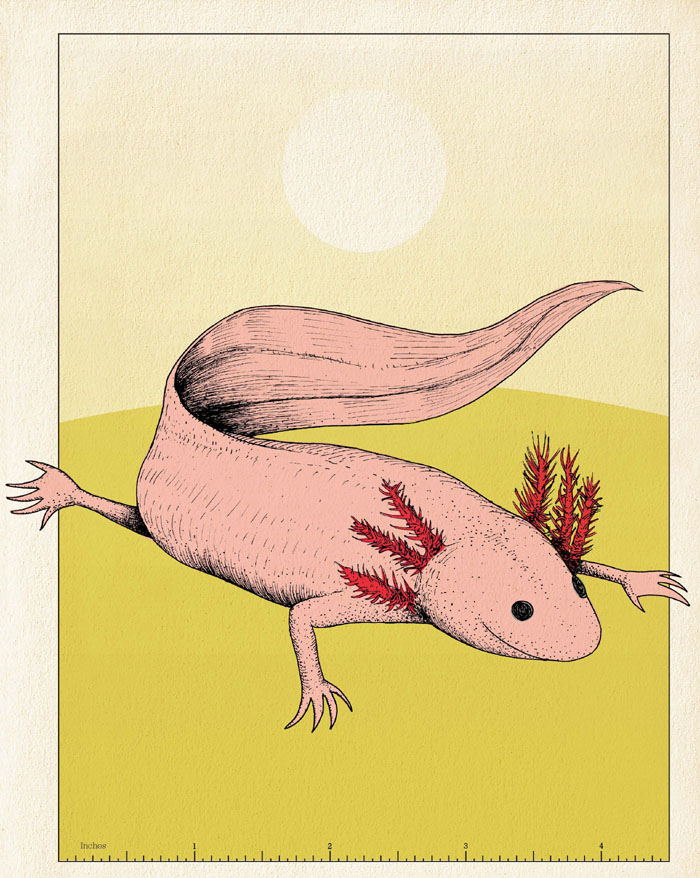
Fig. 2 Axolotl:
The name axolotl comes from the Aztec language. The most common translation is water dog.
SCIENTIFIC NAME: DAUBENTONIA MADAGASCARIENSIS
KINGDOM Animalia
PHYLUM Chordata
CLASS Mammalia
ORDER Primates
FAMILY Daubentoniidae
GENUS Daubentonia
SPECIES D.madagascariensis


